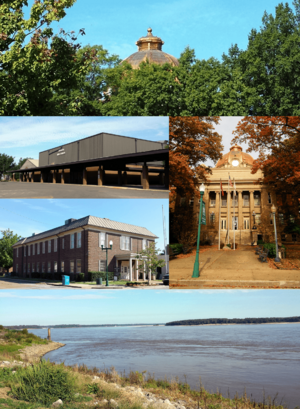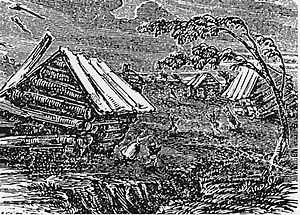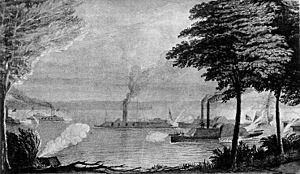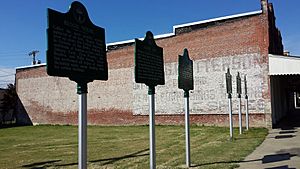Osceola, Arkansas facts for kids
Quick facts for kids
Osceola, Arkansas
|
|
|---|---|

Clockwise from top: Mississippi County Courthouse copper dome is visible among mature trees as seen from the Hale Avenue Historic District, the courthouse grounds and main entrance, the Mississippi River at Sans Souci landing, Mississippi County Library, Osceola High School
|
|

Location in Mississippi County, Arkansas
|
|
| Country | United States |
| State | Arkansas |
| County | Mississippi |
| Government | |
| • Type | Mayor–council |
| Area | |
| • Total | 9.42 sq mi (24.40 km2) |
| • Land | 9.42 sq mi (24.40 km2) |
| • Water | 0.00 sq mi (0.00 km2) |
| Elevation | 236 ft (72 m) |
| Population
(2020)
|
|
| • Total | 6,976 |
| • Density | 740.63/sq mi (285.96/km2) |
| Time zone | UTC−6 (Central (CST)) |
| • Summer (DST) | UTC−5 (CDT) |
| ZIP code |
72370
|
| Area code | 870 |
| FIPS code | 05-52580 |
| GNIS feature ID | 2404446 |
Osceola is a city in Mississippi County, Arkansas, United States. It is one of the two places where the county government is located. Osceola is found along the Mississippi River in an area called the Arkansas Delta.
The city was started in 1837 and became an official city in 1853. Because it was in an important spot on the river, its economy grew as more steamboats traveled by. The city became known for harvesting timber (wood) and cotton. It grew very quickly in the early 1900s. Today, Osceola has many different types of industries. In 2020, about 6,976 people lived there.
Contents
History of Osceola
Early Times
Before Europeans arrived, the area where Osceola is now was mostly swampland with thick forests. Native American tribes lived here. Europeans began to explore the area around 1803, after the Louisiana Purchase.
From Louisiana Purchase to Becoming a State
At first, only a few people settled in this remote area. Then, in 1811–1812, very strong earthquakes hit the region. These were the 1811–1812 New Madrid earthquakes, coming from the New Madrid Seismic Zone. The earthquakes caused the ground to shake so much that it changed the land. Some areas sank over 50 feet (15 meters) and became new lakes or swamps.
After the earthquakes, more people came to the area. Two settlers, William and John Edrington, bought land from Native American tribes along the Mississippi River. The area had lots of timber and easy river access, which helped it grow. In 1837, the settlement was named "Plum Point."
Before the Civil War, During, and After
Plum Point became a busy stop on the Mississippi River. It was also a place where timber was gathered for the steamboats that traveled the waterways. Settlers soon found that the rich soil was great for growing crops, especially cotton. Cotton was very popular in the Southern United States because European factories needed a lot of it.
Farmers from other states moved to Mississippi County, bringing with them the practice of growing cotton on large farms called plantations. In 1853, the community had about 250 people and officially became the city of "Osceola."
During the American Civil War, Osceola supported the Southern states. A group of volunteers from Osceola, called the Osceola Hornets, fought for the Confederacy. In 1862, thousands of Union soldiers came to the area to attack nearby forts. A naval battle also happened on the river near Osceola. The city itself was often raided by both armies, causing damage.
After the Civil War, life changed a lot. People who owned plantations had lost their enslaved workers. Poor white people and formerly enslaved people now competed for jobs and social standing. This led to many problems and conflicts. There was a lot of unrest and violence in Mississippi County and other parts of Arkansas. Because of this, the governor declared a special law called martial law in Mississippi County and other counties from November 1868 to March 1869 to try and bring order.
A New Era
Osceola is the main county seat for Mississippi County. This means it's where the county government offices are. There's also a second county seat in Blytheville, which was added in 1901.
In the center of Osceola is the beautiful Mississippi County Courthouse, built in 1912. It has a copper-covered dome. The courthouse is surrounded by other old buildings that are important to history. The Mississippi County Historical Center is in a building from 1904 that used to be a store.
Osceola is also known for its part in the history of blues music. Many famous blues musicians came from or played in Osceola. To celebrate this, the city has held the Osceola Heritage Festival every year since 1998.
Geography of Osceola
Osceola is in the eastern part of Mississippi County. Its eastern edge is along the levee that protects it from the Mississippi River. The state of Tennessee is just across the river. To the west, the city limits reach Interstate 55. This highway goes north to Blytheville and south to West Memphis. U.S. Route 61 is the main road that goes through the middle of Osceola.
The city of Osceola covers about 9.4 square miles (24.4 square kilometers) of land.
The Arkansas Delta Region
Osceola is located in the Arkansas Delta. This is one of the six main geographic areas in Arkansas. The Arkansas Delta is part of a larger flat area called the Mississippi Alluvial Plain. This plain has very rich soil because of sediment left by the Mississippi River.
Earthquakes and Geology
Osceola is in the New Madrid Seismic Zone. This is an area where earthquakes happen often. The strongest earthquake in eastern North America happened here in 1811–1812.
The Mississippi River
The Mississippi River forms the eastern border of Osceola and separates Arkansas from Tennessee. The river has been very important to Osceola since it was founded in 1833. It helped the city grow by allowing timber and cotton to be shipped easily.
However, the river has also caused problems. The Great Mississippi Flood of 1927 and another flood in 1937 caused a lot of damage to Osceola. Hundreds of people had to leave their homes, and crops were ruined.
Climate
Osceola has a humid subtropical climate. This means it has hot, humid summers and mild winters.
| Climate data for Osceola, Arkansas | |||||||||||||
|---|---|---|---|---|---|---|---|---|---|---|---|---|---|
| Month | Jan | Feb | Mar | Apr | May | Jun | Jul | Aug | Sep | Oct | Nov | Dec | Year |
| Mean daily maximum °F (°C) | 45 (7) |
51 (11) |
60 (16) |
71 (22) |
80 (27) |
89 (32) |
92 (33) |
90 (32) |
84 (29) |
74 (23) |
60 (16) |
49 (9) |
70 (21) |
| Mean daily minimum °F (°C) | 28 (−2) |
32 (0) |
41 (5) |
49 (9) |
59 (15) |
67 (19) |
71 (22) |
68 (20) |
60 (16) |
48 (9) |
40 (4) |
31 (−1) |
50 (10) |
| Average precipitation inches (mm) | 3.69 (94) |
3.78 (96) |
4.87 (124) |
4.90 (124) |
5.57 (141) |
4.06 (103) |
3.56 (90) |
2.67 (68) |
3.65 (93) |
3.38 (86) |
4.84 (123) |
4.55 (116) |
49.52 (1,258) |
Population of Osceola
| Historical population | |||
|---|---|---|---|
| Census | Pop. | %± | |
| 1880 | 317 | — | |
| 1890 | 458 | 44.5% | |
| 1900 | 953 | 108.1% | |
| 1910 | 1,769 | 85.6% | |
| 1920 | 1,755 | −0.8% | |
| 1930 | 2,573 | 46.6% | |
| 1940 | 3,226 | 25.4% | |
| 1950 | 5,006 | 55.2% | |
| 1960 | 6,189 | 23.6% | |
| 1970 | 7,892 | 27.5% | |
| 1980 | 8,881 | 12.5% | |
| 1990 | 8,930 | 0.6% | |
| 2000 | 8,875 | −0.6% | |
| 2010 | 7,757 | −12.6% | |
| 2020 | 6,976 | −10.1% | |
| U.S. Decennial Census | |||
2020 Census Information
| Race | Num. | Perc. |
|---|---|---|
| Black or African American | 3,893 | 55.81% |
| White | 2,569 | 36.83% |
| Native American | 45 | 0.1% |
| Asian | 45 | 0.65% |
| Other/Mixed | 240 | 3.44% |
| Hispanic or Latino | 222 | 3.18% |
In 2020, there were 6,976 people living in Osceola. There were 2,750 households and 1,728 families.
2010 Census Information
In 2010, Osceola had 7,757 people. The population was made up of 53.9% Black people, 41.9% White people, 0.1% Native American, 0.2% Asian, and 1.3% from two or more races. About 2.5% of the people were Hispanic or Latino.
Education
Students in Osceola attend schools in the Osceola School District. They go to Osceola High School. The school's mascot is the Seminole, and the school colors are purple and gold.
City Services (Infrastructure)
The City of Osceola Public Works Department provides important services to the city. These include the Animal Shelter, Code Enforcement, Fire Department, and Police Department. There's also a city-owned company called Osceola Municipal Light & Power. It handles electricity, streets, sanitation (trash), and water services.
Electricity
Osceola Municipal Light & Power provides electricity to homes and businesses in Osceola. They get power from their own facilities and also buy it from another company.
Water and Wastewater
Osceola gets its drinking water from the Wilcox Aquifer, which is about 1,500 feet (457 meters) underground. Water is pumped up, treated to remove iron, and then chemicals like chlorine and lime are added to make it softer. The water is stored in large tanks before being sent to homes and businesses. The city has about 45 miles (72 kilometers) of water pipes. Osceola uses about 1.75 million gallons (6.6 million liters) of water each day.
Wastewater (used water from homes and businesses) is collected through a system of pipes and pumping stations. It goes to the Osceola Wastewater Treatment Facility. Here, the water is cleaned in large ponds for two to four months. After it's clean, it's released into the Mississippi River.
Industries in Osceola
Osceola is home to several companies that make different products.
- American Greetings, a very large greeting card company, opened a factory in Osceola in 1961. It's the biggest factory building in Arkansas, covering 2.6 million square feet (60 acres). It's also the largest employer in Mississippi County.
- In 2016, Big River Steel opened in Osceola. This is a huge steel mill that makes flat steel for cars, oil and gas, and electrical industries. It's one of the most advanced construction projects ever in Arkansas.
- In 2022, Envirotech Electric Vehicles announced they would move their manufacturing to Osceola. This will create about 800 jobs and involve a large investment.
Other industries in Osceola include:
- Actagro – Makes fertilizers.
- Arkansas Steel Processing – Cuts steel.
- Bunge Corp – Deals with grain.
- Consolidated Grain and Barge – Also deals with grain.
- DENSO Manufacturing – Makes car air conditioners and radiators.
- Evonik CYRO – Makes acrylic plastic sheets.
- Kagome Creative Foods – Makes margarine, flavored oils, and seasonings.
- Mid-River Terminal – Loads and unloads barges.
- NAES Plum Point Power Station – A power plant.
- Producers Mid-South – Makes cottonseed products.
- SMS Millcraft – Does industrial maintenance.
- Systex Products – Makes HVAC parts for Toyota.
- Telling Industries – Makes steel studs.
- Viskase Corp – Makes casings for the meat industry.
Famous People from Osceola
Many notable people have connections to Osceola:
- Bill Alexander, a U.S. Representative.
- David Barrett, a former NFL cornerback.
- Joseph H. Bradford, a lawyer and state legislator.
- Maurice Carthon, a former NFL and USFL player.
- Ran Carthon, a former NFL running back and current general manager for the Tennessee Titans.
- Dale Evans, a TV and movie star, wife of Roy Rogers.
- Calvin Frazier, a blues guitarist.
- Buddy Jewell, the first winner of Nashville Star.
- Cortez Kennedy, a former NFL defensive lineman.
- Albert King, a famous blues musician.
- Robert "Say" McIntosh, a political and civil rights activist.
- Gaylon Nickerson, a former NBA player.
- Bill Ramsey, played baseball for the Boston Braves.
- Billy Lee Riley, a rockabilly music star.
- Harvey Scales, a rhythm and blues and soul music performer.
- Son Seals, a blues guitarist.
- Jimmy Thomas, a soul singer.
- James Williams, a former NFL player.
- Kemmons Wilson, who founded Holiday Inn.
- Reggie Young, a guitar legend who recorded with Elvis and others.
See also
 In Spanish: Osceola (Arkansas) para niños
In Spanish: Osceola (Arkansas) para niños







